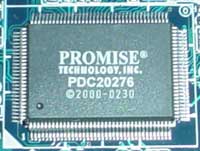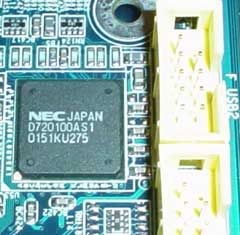Intel announces DDR333 Chipsets: 3-way 845PE shootout
by Evan Lieb on October 7, 2002 5:22 AM EST- Posted in
- Motherboards
Gigabyte 8PE667 Ultra Rev. 1.0: Basic Features
|
Motherboard Specifications |
|
|
CPU
Interface
|
Socket-478
|
|
Chipset
|
Intel
82845PE MCH
Intel 82801DB ICH |
|
Bus
Speeds
|
100
- 355MHz (in 1MHz increments)
|
|
Core
Voltages Supported
|
up
to 1.725V (in 0.025V increments)
|
|
I/O
Voltages Supported
|
N/A
|
|
DRAM
Voltages Supported
|
up
to 2.8V in 0.1V increments
|
|
Memory
Slots
|
3
184-pin DDR DIMM Slots
|
|
Expansion
Slots
|
1
AGP 4X Slot
6 PCI Slots |
|
Onboard
RAID
|
Promise
PDC20276
|
|
Onboard
USB 2.0/IEEE-1394
|
USB 2.0
Supported through South Bridge
External 4-port NEC USB2 controller |
|
Onboard
LAN
|
Intel
Kinnereth (ICH4)
|
|
Onboard
Audio
|
Realtek
ALC650 6-channel audio
|
|
BIOS version
|
F3b (preproduction)
|
Gigabyte's 845PE board offers a very good feature set, with a few more bells and whistles than Alabtron's PX845PEV Pro motherboard but fewer features than ASUS's P4PE.

Gigabyte included some fairly common LAN and sound chips with the 8PE667 Ultra. The onboard sound is powered by Realtek's ALC650 chip. This is exactly the same sound chip found on Albatron's 845PE board (PX845PEV Pro).
The LAN chip Gigabyte chooses is not so common however. As we just mentioned, usually you see onboard LAN chips in the form of Realtek's 8100 series of chips. However, Gigabyte opted for Intel's Kinnereth LAN chip, which is simply the native LAN PHY found in the ICH4 South Bridge. Nothing special about it, it's just a regular 10/100 Ethernet chip.

The 8PE667's I/O configuration is pretty common as well. Gigabyte decided to include two PS/2 ports, one parallel port, two serial ports, two rear USB 2.0 ports, a LAN port, and a Game Port, which you will be using if you decide to take advantage of the onboard 6-channel sound.

As is now the norm with most high-end Gigabyte boards these days, there's a Promise RAID chip included with the 8PE667 Ultra. This is quite a conventional RAID chip, offering two channels per connector (therefore up to four IDE devices) in addition to RAID 0 (striping) and RAID 1 (mirroring). The Primary and Secondary IDE connectors, as is the norm, also provide two channels per connector, or up to four IDE devices. In total, you can connect a max of eight IDE devices with the Gigabyte 8PE667 Ultra.

Gigabyte also adds on an NEC USB 2.0 chip. The 845PE chipset natively supports up to six USB 2.0 ports, and so the NEC adds even more USB 2.0 ports to the Gigabyte 8PE667 Ultra's arsenal. Therefore, the Gigabyte 8PE667 Ultra is able to support a massive ten USB 2.0 ports (six from the chipset and four from the NEC chip). This is definitely overkill for the vast majority of users, but nice nonetheless.










0 Comments
View All Comments